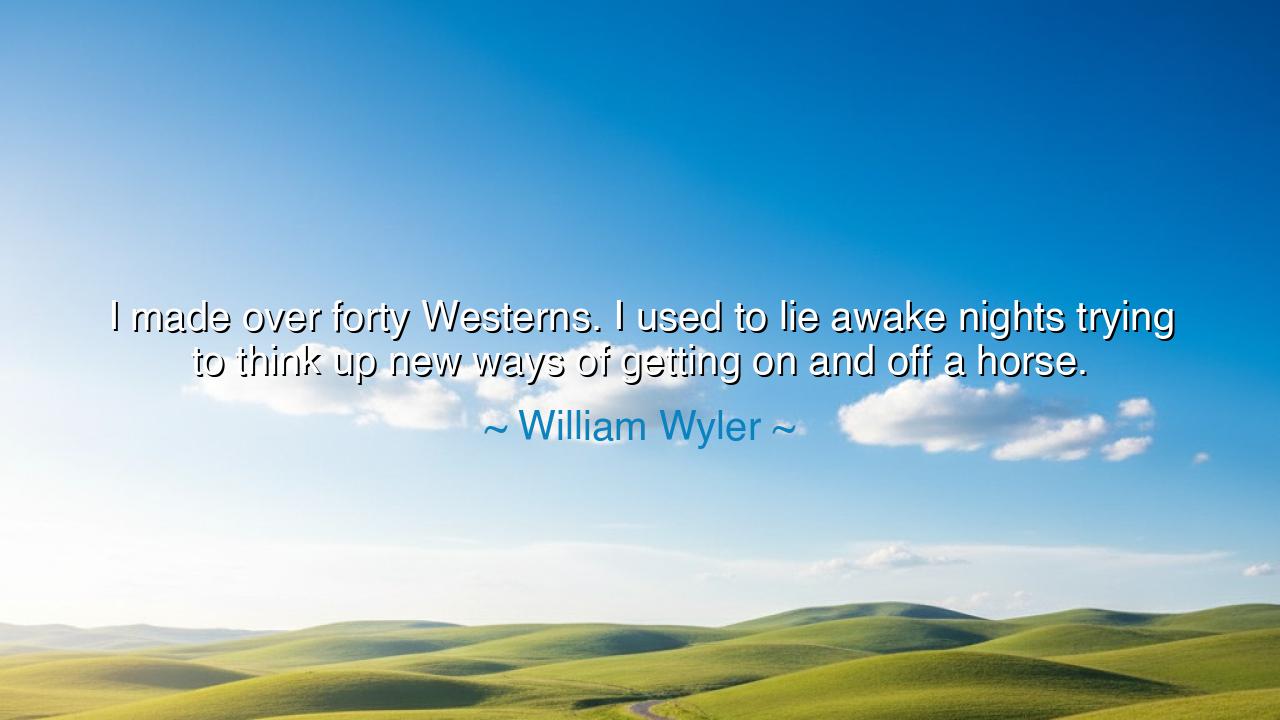
I made over forty Westerns. I used to lie awake nights trying to
I made over forty Westerns. I used to lie awake nights trying to think up new ways of getting on and off a horse.






"I made over forty Westerns. I used to lie awake nights trying to think up new ways of getting on and off a horse." These words from William Wyler, the master director of cinematic epics, reflect the intensity and dedication that come with the creative process. Wyler, who worked in the era of the classic Hollywood Western, was not only concerned with telling compelling stories but also with perfecting the details that brought those stories to life. In this seemingly simple statement, Wyler reveals something deeper about the nature of art and craft—the constant quest for innovation and the creative problem-solving that drives true artistic excellence.
In the world of the Western, where the rugged landscapes of the American frontier serve as both backdrop and character, the image of the rider is central. The act of getting on and off a horse, though seemingly mundane, is in fact a powerful gesture of movement, a visual representation of the freedom, adventure, and tension that defined the genre. Wyler’s pursuit of new ways to portray this action speaks to a larger truth about filmmaking—the devotion to the smallest of details, the willingness to labor over even the most routine aspects of a scene in order to bring freshness and energy to the story. Just as the horse is an enduring symbol of the Wild West, Wyler understood that even the most familiar gestures could be made to speak volumes about the character and the world they inhabited.
The same level of attention to detail can be found in the works of other great filmmakers, such as Akira Kurosawa. Kurosawa, like Wyler, was a master of action and movement, using the physicality of his characters to tell deeper stories. In his samurai films, Kurosawa would often spend days rehearsing the smallest gestures—how a sword was drawn or how a character moved through a scene—to ensure that every action conveyed meaning. In both Wyler’s Westerns and Kurosawa’s samurai epics, the act of getting on and off a horse—or drawing a sword—is not just a physical act but a reflection of the character’s internal state and the world around them. These moments, though simple, are infused with symbolism and serve as a reflection of the broader themes of the story.
This deep focus on craftsmanship reveals an essential truth about all forms of creative work: it is the attention to detail, the commitment to innovation, and the desire to perfect even the most seemingly insignificant elements that elevate a work of art from good to great. The ancient Greeks, too, understood this when they sought to perfect their craft in sculpture, theatre, and philosophy. The sculptor Phidias, for example, labored tirelessly over the smallest details of the Parthenon, not merely because it was his job, but because he understood that each detail mattered in the larger creation of something sublime. The same principle applies in filmmaking: the director must not only shape the grand narrative but also focus on the smallest of gestures to convey deeper layers of meaning.
Wyler’s words also reveal a deeper philosophy of work—the understanding that creativity requires constant effort and discipline. It is easy to assume that great artists are simply inspired by flashes of genius, but the truth is that art often requires hard, sometimes even tedious, work. Wyler’s sleepless nights spent thinking of ways to bring a fresh energy to something as simple as getting on or off a horse show that creativity is not always about waiting for inspiration to strike, but about dedication to the process, and the willingness to grind through the smallest tasks to achieve something larger. Persistence, not merely genius, is often the key to excellence.
In our own lives, the lesson from Wyler’s dedication to the craft of filmmaking is one of commitment and attention to detail. Whether we are artists, professionals, or individuals pursuing any goal, it is not enough to merely strive for the grand vision; we must also dedicate ourselves to the seemingly small, mundane actions that contribute to that vision. Each step, each choice, each moment counts. Like Wyler with his horses, we too must constantly seek new ways to bring freshness and energy to our work, even if it means laboring over the smallest of details. The pursuit of excellence is not just about the end result but about finding joy and purpose in the journey itself.
Thus, let us take Wyler’s example as a reminder to embrace the small details in our work, to appreciate the process, and to dedicate ourselves fully to the pursuit of craft. Just as Wyler’s films continue to stand as testaments to his commitment to storytelling, so too can our own efforts, when rooted in dedication and care, become lasting legacies. Let us not shy away from the hard work of perfecting the small tasks—for it is in these that the true spirit of our creative efforts lies. As we strive for excellence, may we remember that every movement, every action, and every detail is an opportunity to shape something meaningful and enduring.






AAdministratorAdministrator
Welcome, honored guests. Please leave a comment, we will respond soon